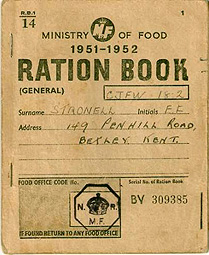Dig for Victory was a Response to a Wartime
Problem of Food Shortages
Throughout history one of the
main reasons wars were lost was caused by lack of
food. Sieges were used throughout history as a means
of depriving the state of food until a surrender had
been reached.
In the years leading up to
World War 2 Great Britain had imported seventy five
percent of its food a year or about 55 million tonnes
a year.
In September 1939 at the
start of World Second World the shipping that
was importing this food supply was being attacked by
enemy submarines.
These ships were also carrying war
materials so the import of food was being lessened
both by reduction of food supplies and the amount of
space available on the cargo ships.
In October 1939 the Government launched 'The Dig for Victory'
campaign. People were urged to use gardens and every spare piece of
land, such as parks, golf clubs and tennis courts, to grow
vegetables.
By November 1939 the Phrase Dig for Victory had
entered into the public consciousness When the
Minister for Agriculture encouraged the project by
saying, "Let Dig for Victory be the motto of
everybody with a Garden".
The Tower of London
was used to grow vegetables to promote the dig for victory.
Even the moat at the Tower of London was used to grow vegetables.
Victory gardens were growing their own food in very tight compact
spaces as a response to food shortages due to the wartime
restrictions on food imports.
Rationing in the United Kingdom is the series of food rationing
policies put in place by the government of the United Kingdom. At
the beginning of World War II, the UK imported 55 million tons of
foodstuffs per year (70%), including more than 50% of its meat, 70%
of its cheese and sugar, nearly 80% of fruits and about 90% of
cereals and fats.
It was a main objective for the Axis Powers to
destroy the ships carrying cargo to the United
Kingdom. This strategy could potentially starve the
country and cause it to submit to the Axis powers.
Each person would register with their local shops, and was
provided with a ration book containing coupons. The shopkeeper was
then provided with enough food for his or her registered customers.
When purchasing goods, the purchaser had to give the shopkeeper a
coupon as well as money
Food rations in 1943 Britain per person
1 shilling
2 penny |
(1 lb 3 oz or 540 g) of
meat (offal or sausages were rationed later on from 1942-1944) |
| 4 oz (113 g) |
bacon |
| 3 pints (1.7l) |
milk each week or
1 packet of milk powder per month |
| 1
egg (week) |
egg powder made 12
eggs or 1 packet allowed per month (vegetarians allowed
two eggs) |
|
2 oz
(57 g) |
fat or lard |
| 2 oz
(57 g) |
loose tea leaves (teabags
were not in common use in the UK at the time) |
| 2 oz
(57 g) |
butter |
|
2 oz
(57 g) |
margarine |
|
2 oz
(57 g) |
jam |
| 3 oz (85
g) |
sugar |
| 1 oz (28 g) |
cheese (vegetarians
could have 3 oz (85g) of extra cheese because they did not
use their meat ration) |
|
3 oz (85 g) |
sweets |
|
 |
Dig for Victory allotment gardens and what to grow on them.
|
|
People were encouraged to grow what they liked to eat. The mainstay
crops were:
|
|
Brussel sprouts,
Cabbage,
Carrot,
dwarf and broad beans
Globe beet,
Kale, Swede,
Lettuce.
Marrow,
Onions,
Parsley,
Parsnip,
Potatoes,
Radish,
Runner beans,
Shallots,
Spinach,
Sprouting broccoli,
Tomatoes,
Turnip,
|
 |
|
Government leaflets were published and regular updates based on seasonal
considerations were
delivered to the population as well as instructions on using tool sheds, seed
bed planting and composting.
Effort was made to promote recycling and good land management. One method that is still used is
to build walls in a square and fill this with soil. This allows for deep rooting food plants to be put in
tight places not normally available for these type of plants.
Companion planting was introduced, this is a method of planting
different plants in the same bed. Different plants attract different
pests and diseases so by planting them next to each other insects can be
repelled or attracted as needed for the plants satisfactory growth.
An organic approach to gardening was introduced more to increase the
yield and nutrition of crops than for environmental reasons, however
many of these methods remain in use because they worked so well.
The plots also made use of discarded household items. Things like Egg
cartons and toilet roll tubess could be used for germinating seedlings and old window frames
placed over young plants made
good cold frames.
Net curtains for netting provided protection for the young from birds and hot sun
by deflecting the suns rays away from the young plants.
In WW2 British Restaurants were exempt from rationing
Restaurants were exempt from rationing, which led to a certain
amount of resentment as the rich could supplement their food
allowance by eating out frequently and extravagantly.
Rules were created to stop this. meals had to be
sold for under five shillings (about 25p) and
restaurants could not have any menus that included
meals of more than three courses
Local Authorities set up what were known as "British Restaurants."
The Restaurants gave their clientele the experience of going out for
a restaurant meal and breaking up some of the monotony. British
Restaurants were run by local authorities, who set them up in a
variety of places from schools to church halls.
Three course meals were priced at 9d (about
0.04p). The meals varied greatly in quality from
place to place but the good ones were well liked and
a large number of people used them regularly.
A Dig for Victory garden cook book.
New recipes had to be created in World War 2 to make the best use
of rationing and the produce from victory gardens such as: Woolton
Pie.
Ingredients
1lb cut potatoes,
1lb cauliflower,
1lb sliced carrots,
1lb, sliced swede,
3 spring onions
A
teaspoon of marmite,
1 tablespoon oatmeal,
Some chopped parsley
|
Woolton Pie
Put everything in a pot just enough water
to cover the ingredients and heat. keep stirring the mixture so
as to stop it sticking to the sides of the pan. Take of the heat
and allow to cool.
Put the mixture into a pie dish and put on
a little chopped Parsley.
Put on some sliced potatoes or top with
some whole wheat pastry.
Put in a moderately hot oven and bake the
wollton pie until the top goes a gold brown colour.
Serve hot with gravy.
|
Woolton Pie
|
This recipe was created by the Chef of the Savoy hotel and named after Lord Woolton,
head of the Ministry Of Food
Carrots help you see in the dark
At one point there was a glut of carrots, and the Government let
it be known that carotene, which is believed to help night vision,
was largely responsible for the RAF’s increasing success in shooting
down enemy bombers.
The general public took this to heart and began
eagerly eating more carrots. After all there were
blackouts at night which meant all street lights off
and all windows blacked out. Carrots seemed to be
the obvious answer to this problem.
This not only solved the problem of a carrot glut
but also disguised the reason that the RAF's
improving success rate was largely due to the
improvements in radar and its ability to be used in
planes.
Dig for Victory garden made from a bomb crater
Conclusion
During WW2 the British were making Victory gardens anywhere
available and parks, village and town squares in fact anywhere where
food could be planted. The Dig for Victory campaign allowed food to
be grown in increasingly small and tight little areas.
This added to
the creativity and problem solving of the nation as they struggled
to support themselves in the time of great food shortages caused by
the restrictions on food supplies from overseas.
The end of the twentieth century saw a resurgence
of these ideas. With growing concerns about the
availability and quality of foods and a general
public awareness of the damage caused to the
environment a rethink on food production had become
relevant.
By transporting food around the world use of
chemicals and a change in climate it was and is
necessary to produce more food locally.
A resurgence of allotment use and organic growing
methods have drawn much inspiration from the
techniques used in the dig for victory campaign. A
wealth of websites and forums have built up around
this subject
Wartime dig for victory principles of eating seasonal food grown locally and
organically have a message for us now. The information is still
completely current and with the constant fears of food shortages,
environmental issues and
economic problems there is a new interest in these techniques to
grow more of your own food.
|
